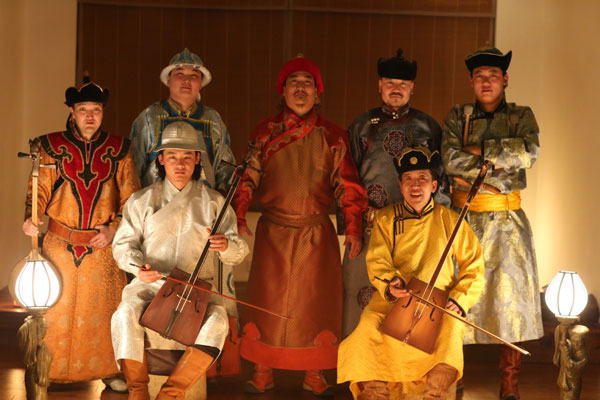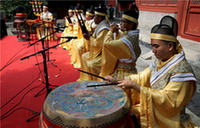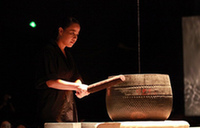Whistling meadows
Updated: 2014-09-22 07:39
By Chen Nan(China Daily)
|
||||||||
 |
|
Naranbadrakh (center) and his team of performers present a Beijing concert on Sept 21.[Photo provided to China Daily] |
"It's more difficult for women than men to perform the singing style, because their vocal cords are different," she says. "But the training was rewarding since it has opened my vocal range and helped me gain much strength while singing and breathing."
 |
Naranbadrakh, a well-known khoomei singer from Mongolia, who conducted the classes, performed in a concert in Beijing on Sept 21. He has made many khoomei presentations in China since 1997 but taught here the first time this month. Five other Mongolian khoomei singers, including Battumur and Altantug, also participated in the concert titled Call of Mongolia.
The origins of khoomei are uncertain. According to Naranbadrakh, it is believed to have originated from herders' imitations of animal sounds and was later incorporated into religious rituals.
"The core of khoomei is not just to show off the skill onstage, but to feel the power of the ancient art and acquire peacefulness at heart. I think the students have gained their own understanding of the art," says Naranbadrakh, 36, who lives in Ulan Bator, Mongolia's capital.
Despite his childhood dream of becoming a professional wrestler, he started learning khoomei in 1994 from Odsuren, a Mongolian master of the form.
Odsuren also introduced the throat-singing tradition to his country's university syllabus and has taught the skill to more than 1,000 Chinese students since he first visited China in 1993.
"Khoomei is closely connected with nature and the Mongolian language. Like Peking Opera and Italian opera, despite the cultural and linguistic differences, khoomei can be enjoyed by the world's audiences," Odsuren had said in an earlier interview.
In 2011, Temur, a famous Chinese khoomei vocalist, invited Odsuren, 73, to launch the Odsuren Khoomei School in the Inner Mongolia autonomous region's capital, Hohhot. Hundreds of students from around the world have since received khoomei training there.
Tekexi, who is the younger brother of Temur, is a khoomei promoter at the Beijing Exchange Center of the Odsuren School of Khoomei Art. Besides offering training and staging performances, the center also plans to teach traditional Mongolian instruments and language.
Naranbadrakh points out that khoomei, along with its long-drawn songs and the use of matouqin, a traditional string instrument, is highly regarded in Mongolia. Khoomei is not only a national treasure protected by the government but also an art form appreciated by young Mongolians, he says.
"Khoomei has been incorporated into many musical genres such as pop, rock and rap. But the study of khoomei should be serious and solid," says Naranbadrakh, who has also introduced some pop into his old art form.
"Though most Mongolians now live in urban areas, we bear our roots in mind. We have the responsibility to take this art to more people."

 Star Stefanie Sun holds concert in Beijing
Star Stefanie Sun holds concert in Beijing
 Faye Wong's manager refutes star's drug rumors
Faye Wong's manager refutes star's drug rumors
 Lu Yi and daughter Bei Er pose for street snaps
Lu Yi and daughter Bei Er pose for street snaps
 Photoshoots of actress Li Xiaomeng
Photoshoots of actress Li Xiaomeng
 Council of Fashion Designers of America Awards
Council of Fashion Designers of America Awards
 Fan Bingbing, first Chinese actress in Barbie Hall of Fame
Fan Bingbing, first Chinese actress in Barbie Hall of Fame
 Awarding ceremony of 2014 hito Pop Music held in Taipei
Awarding ceremony of 2014 hito Pop Music held in Taipei
 Zhao Liying's photo shoot for Children's Day
Zhao Liying's photo shoot for Children's Day
Most Viewed
Editor's Picks

|

|

|

|

|

|
Today's Top News
US group seeks 'no vacancy' for China's hotels
Rio expo gives China a showcase for its oil industry
Alibaba makes IPO history
Security breach prompts more White House security
Man arrested for charging White House had knife
US, Canadian jets intercept 8 Russian aircraft
Li seeks to fast track green cards in FTZ
Fence-jump intruder sparks White House alert
US Weekly

|

|








